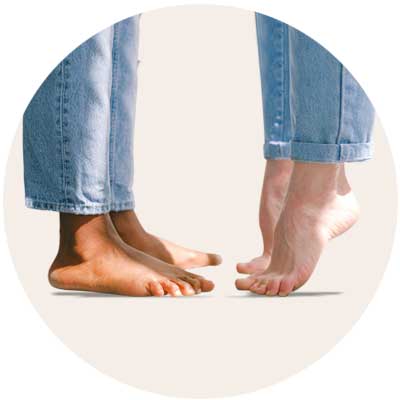
Foot skin problems: symptoms, causes and treatment
The feet are a fundamental part of the body: they are crucial both functionally and aesthetically. Along with the legs, the feet are our main tool for mobility. However, foot health is often compromised due to the burden of walking every day and carrying the body’s weight. These stresses can sometimes trigger considerable motor issues and can cause skin conditions that make even walking difficult. It is therefore very important to safeguard foot health, at both a structural and epidermal level. Let’s find out together the problems of the skin on the feet:
CRACKED HEELS
Cracked heels are a very common skin condition. Heels become cracked due to the physiological stresses that they are subjected to during the day. These stresses include supporting the foot while walking or the use of shoes with rigid soles.
CALLUSES
Calluses are thickenings of the skin that usually appear on the soles of the feet and between the toes. They are rough to the touch and contour the shape of the area on which they form.
BAD FOOT ODOR
Bad foot odor is an unpleasant situation caused by an excessive growth of bacterial colonies that destroy the stratum corneum, the outermost layer of the epidermis. This layer of skin is made up of lamellae, which contain keratin proteins rich in sulfur, chemically enhanced with bacteria. The breakdown of the skin releases foul-smelling sulfur compounds which can, in some cases, lead to the maceration and erosion of the skin. The resulting bad smell then tends to permeate the surrounding areas.
BLISTERS
Blisters are liquid-filled skin lesions. They are extremely common, particularly following intense sports activities, long walks or the use of shoes that do not conform to the shape of the foot. Blisters can form quickly and can be very uncomfortable.
ATHLETE’S FOOT (MYCOSIS)
Athlete’s foot (mycosis), is one of the most common fungal infections and is caused by the proliferation of pathogenic fungi on the skin. It is often referred to as athlete’s foot due to its prevalence among sportspeople, however it is not limited exclusively to athletes and can affect anyone, regardless of activity level or gender.
HYPERHIDROSIS (EXCESSIVE SWEATING)
Hyperhidrosis, or excessive sweating, in the feet is fairly common because the sole of the foot is dense with sweat glands. Hyperhidrosis occurs when sweat glands overact, often as a result of stimuli such as high temperatures or from emotional stimuli, such as stress, fear or excitement. It can also be caused by genetic constitution.
DAMAGED TOENAILS
A healthy nail is smooth, transparent and adherent to the nail bed. On the other hand, signs of a damaged nail can include opaqueness, flakiness, thickness and, in some cases, detachment from the nail bed. These conditions are frequent as the toenails can be subject to various alterations.
DYSHIDROTIC ECZEMA ON THE FEET
Dyshidrotic eczema, also known as pompholyx or dyshidrosis, can be either reactive or inflammatory and causes itchy skin and small, fluid-filled blisters. This condition usually appears on the soles of the feet. Due to its plantar location and name, dyshidrosis can sometimes be confused for a hiperhidrosis. Sweating, however, is not a cause or a consequence of dyshidrosis.
SKIN MACERATION ON THE FOOT
Skin maceration on the foot occurs when there is too much water in the stratum corneum. Combined with high temperatures and humidity, this excess moisture causes bacteria to form which can create discomfort. Maceration usually occurs between the toes, where moisture stagnates the longest, but can also spread to the rest of the foot.
DRY SKIN
Dry skin on the feet is a widespread problem for both women and men, and can be particularly bothersome for older people. In addition to creating aesthetic discomfort, dry skin can cause physical pain if left untreated and, in some cases, can result in complications that may cause serious damage to the skin.









